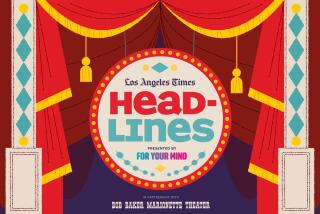Therapy Conquers Panicky Fear of Bugs
- Share via
Leah was so terrified of daddy longlegs that she couldn’t walk across a lawn or enter her vacant apartment without panicking. One night she got so scared that she checked herself into a mental hospital.
With Clara, it was cockroaches. She kept no food in her kitchen and wouldn’t let neighbors visit because she feared that they would bring in roaches.
Gloria sold her house to get away from silverfish.
Before Ellen could carry her bridal bouquet down the aisle, she had to undergo therapy to overcome her fear of bees.
All four women were victims of either entomophobia, the fear of insects, or arachnophobia, the fear of spiders.
An estimated 11.6 million Americans suffer from phobias, the nation’s No. 1 psychiatric disorder. Except for social phobias such as fear of crowds, with which men and women are equally afflicted, women are twice as liable as men to have a phobia, said Jerilyn Ross, a psychologist in Washington who is president of the Anxiety Disorders Assn. of America.
Insect phobias are often instilled by parents but not manifested until adulthood, Ross said. Ellen’s mother, who was terrified of bees, shrieked, “Don’t move!” when a few bees buzzed around her 10-year-old daughter. Ellen, who wasn’t even stung, didn’t become aware of her phobia until she was about to marry.
Most people don’t waste much affection on the creepy-crawly world, but usually it’s only a healthy dislike, not an incapacitating phobia.
Stephen R. Kellert, a professor at the Yale University School of Forestry and Environmental Studies, cites a Connecticut study that found that people are overwhelmingly filled “with strong feelings of anxiety, antipathy and avoidance” toward the “spineless kingdom,” especially arthropods, which include beetles, wasps, scorpions and ticks.
When strong feelings become phobias--involuntary, irrational fears so extreme that they interfere with daily living--specialists like Ross get into the act.
“With a phobia,” said Ross, “it always comes down to the issue of control. People’s greatest fear is a panic attack, losing control. It’s such a horrible feeling that they’ll do anything to escape from it.”
Happily, sufferers of phobias of bugs can be quite easily treated. Leah, Clara, Gloria and Ellen were cured, Ross said, with treatment known as “contextual therapy,” or “in vivo exposure.” The treatment is gradual exposure to the cause of their panic until they challenge their own assumptions and shed their irrational fears.
Ellen shed hers in several therapy sessions amid the bee-filled flower gardens of Lafayette Park across from the White House.
Kellert attributes the general dislike of bugs to several factors, including the sheer numbers of insects, their appearance, unpredictability and mystery.
“You could speculate that when people go around the house squashing bugs and spiders, part of it may be that they are just offended by this violation, this taking of autonomy from them,” he said.
Not all societies are as queasy about bugs as are Western nations.
Michael H. Robinson, director of the National Zoo in Washington, has traveled widely and studied numerous insects. The ancient Egyptians, he said, revered scarab beetles and made bees and flies part of their symbolism.
Many people around the world eat insects. People in Papua New Guinea “know so much about them that they aren’t repelled by them,” said Robinson, who once partook of a native meal of golden orb-weaving spiders.
Invertebrates compose more than 90% of all animal species. Stings and bites notwithstanding, only a tiny number are dangerous to humans.
Peaceful coexistence may never be possible. But better understanding is a goal experts strive for.
“First of all,” said Kellert, “you have to make a better, more compelling case for the value of insects and what it is that’s so important to us. We must understand the basis for people’s negative feelings and in a sense attack them.”
More to Read
Sign up for Essential California
The most important California stories and recommendations in your inbox every morning.
You may occasionally receive promotional content from the Los Angeles Times.










